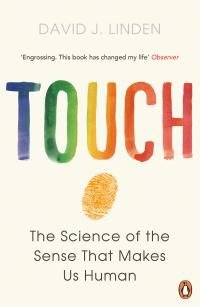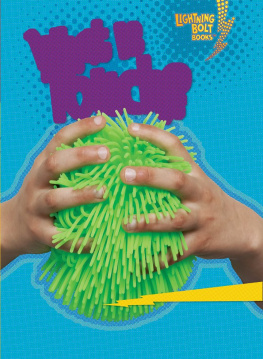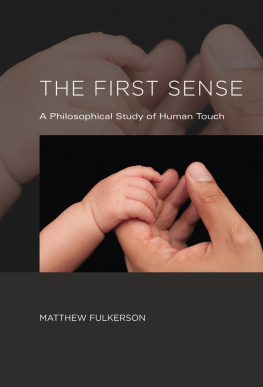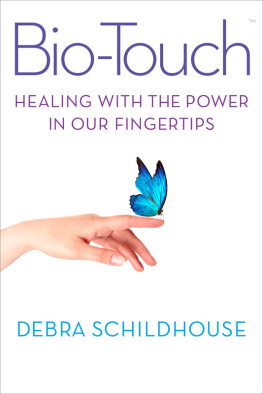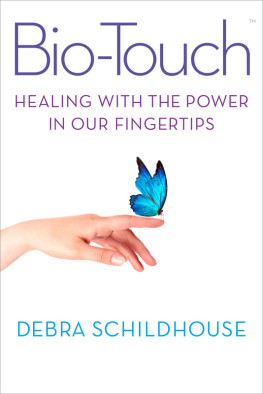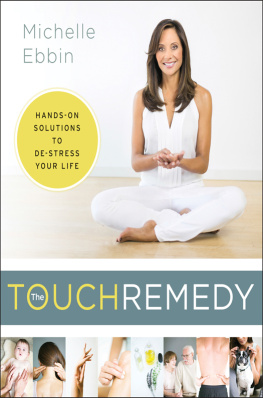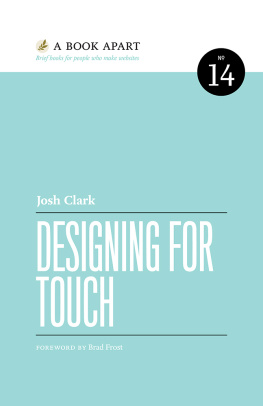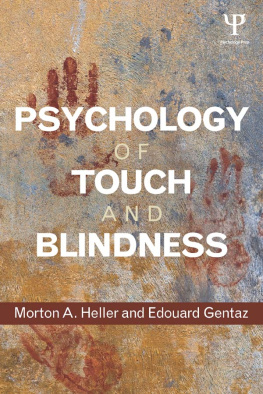Touch
Touch
second edition
Tiffany Field
A Bradford Book
The MIT Press
Cambridge, Massachusetts
London, England
2014 Massachusetts Institute of Technology
All rights reserved. No part of this book may be reproduced in any form by any electronic or mechanical means (including photocopying, recording, or information storage and retrieval) without permission in writing from the publisher.
Library of Congress Cataloging-in-Publication Data
Field, Tiffany.
Touch / Tiffany Field. Second edition.
p. cm.
Includes bibliographical references and index.
ISBN 978-0-262-52659-3 (hardcover : alk. paper)
ISBN 978-0-262-32611-7 (retail e-book)
1. TouchPsychological aspects. 2. TouchTherapeutic use. 3. Massage therapy. I. Title.
BF275.F54 2014
152.1'82dc23
201400801
10 9 8 7 6 5 4 3 2 1
d_r1
Preface
Someone once said that research is me-search, that we study problems that have personal meaning. This is true in my case. I first became interested in the problem of premature infants many years ago when my daughter was born prematurely. At the same time I was doing research on premature infants in my first job as a psychology graduate student. I have continued that research to this day, when my daughter is taller and smarter than I am, possibly in part because we massaged her.
In the world of premature infants today, after they are out of medical jeopardy in the neonatal intensive care unit, they move to what is called the growing unit, where they are to grow enough to be discharged and be taken home by their parents. We first tried to make premature infants grow by having them suck on pacifiers while they were being tube-fed. We found that infants given pacifiers during their tube feedings gained more weight, went off tube feedings earlier, did better on newborn behavior and neurological examinations, and were discharged earlier, at a much lower hospital cost, than infants not given pacifiers.
Although we did not know why the pacifier worked, it did work, and we reasoned that if we stimulated even more areas on their bodies, the infants might gain even more weight. Several people had previously tried to give babies extra touch therapy, but the babies had not shown any growth gains, most likely because the researchers were touching too lightly, which was like being tickled. We have since found that moderate pressure is key to the massage therapy effects.
At the same time that we were massaging infants, our collaborator, Dr. Saul Schanberg from Duke University, was conducting studies on mother rats and rat pups. He found that the pups failed to thriveand, in fact, diedwhen they were deprived of tongue-licking touch from their mother (tongue licking is the primary way that mother rats touch their pups). Another colleague, Dr. Jeannie Brooks-Gunn, reported these remarkable findings to Jim Burke, then CEO at Johnson & Johnson, who then invited us to share our findings with his company, which had just launched a mother-baby love campaign to encourage parents to massage their babies. Burke understood the healing power of touch and commented that he believed that loving touch could save the world not only from disease but also from war. His vision was shared by others at Johnson & Johnson, including Bob Rock, who had conducted roundtables on touch there, and Jim Dettre, who had done most of the groundwork for implementing touch research.
Despite the fact that touch is the largest sense organ (because the skin is the largest organ in the body), it is the one most taken for granted and the one most overlooked when it comes to research efforts. Several research institutes study vision, hearing, smell, and taste, but in 1992, thanks to a seed grant from Jim Burke and later funding by Julia Freedman from Johnson & Johnson, as well as funding from other private corporations and the National Institutes of Health, we established the Touch Research Institute at the University of Miami School of Medicine. To date, we have conducted over one hundred studies on touch and touch therapies.
Although the many therapeutic benefits of touch have become increasingly clearbenefits such as decreases in stress and anxiety and their behavioral and biochemical manifestations, and the positive effects that touch has on growth, brain waves, breathing, heart rate, even the immune systemwe still have touch taboos in the United States. A study we conducted on touch in preschool nurseries revealed that children under the age of five were being touched less than 12 percent of the time, even in model nursery schools. If touch is as critical for growth, development, and health, as it appears to be in our studies, then we need more touch in our society. This book, about the importance of touch and touch therapy for our health, development, and well-being, and for the good of our culture, is our contribution toward that end. The first three chapters focus on the sociology and anthropology of touching and the basic psychophysical properties of touch. The remaining five chapters describe recent research on the value of touch therapies for everyone, from children with asthma and those with autism to cancer patients and those with eating disorders.
Research conducted at the Touch Research Institute on the benefits of touch and touch therapy was the impetus for this book. The intent was to share the firsthand knowledge of the important role that touch plays in our lives and to try and reverse the minimal-touch problem that keeps us from fully experiencing its many benefits.
Clinicians regularly ask us how prolonged the effects of massage therapy are, and we have to respond that we could no more expect long-term effects if the massages were stopped than we could expect long-term effects of dieting if the dieting was stopped. Like diet and exercise, people may need a daily dose of touch.
Touch has been called by Ashley Montagu the least researched of the senses. This second edition retains most of the same material as the first edition and reviews touch research published after 2001. I briefly summarize studies on the role of touch in early development, including touch deprivation and touch aversion; on touch in communication, including reading emotions by touch and facilitating personal relationships by touch; on physiological and biochemical effects of touch, including areas of the brain that are affected by touch; and on massage therapy effects on conditions including prematurity, attentiveness, depression, pain, and autoimmune and immune conditions.
I also review new research on touch effects on compliance in different situations and virtual reality touch, as well as touch in medical practice and in sports. I review magnetic resonance imaging (MRI) data showing activation of the orbitofrontal cortex and the caudate cortex during affective touch. I examine the physiological and biochemical effects of touch and massage therapy, including decreased heart rate, blood pressure, and cortisol and increased oxytocin. I explore as well the potential underlying mechanisms, including moderate pressure massage being mediated by the stimulation of pressure receptors that leads to increased vagal activity. Increased serotonin and, in turn, decreased substance P may lead to the pain-alleviating effects of touch. Moderate pressure massage also leads to increased attentiveness and positive shifts in frontal electroencephalogram, decreased depression, and enhanced immune function, including increased natural killer cells that ward off viral, bacterial, and cancer cells, suggesting that massage is an effective therapy.
The recent research on touch can generally be grouped under the categories of (1) perception of different forms of touch (light versus moderate pressure touch); (2) integration of different senses, including enhancement of touch by vision and synesthesia (sensing touch from viewing someone else being touched); and (3) touch in communication, as in reading emotions through touch, enhancing maternal and romantic relationships, and contributing to better performance in basketball and football. The increasing use of functional MRI and biochemical assays has added to our knowledge about areas in the brain that light up during these touch experiences and neurohormones that are released, new knowledge that highlights the importance of touch for our health and well-being.
Next page

